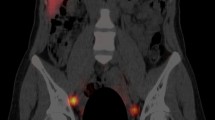Abstract
Objective
Lymphoscintigraphy and sentinel node biopsy are used for the detection of axillary lymph node metastasis in breast cancer patients. However, currently there is no standardized technique. For the detection of axillary lymph node metastasis by lymphoscintigraphy and sentinel node biopsy, in patients with breast cancer, we compared the results of subareolar injections administered on the day of surgery (1-day protocol) with injections administered on the day before surgery (2-day protocol).
Materials and methods
This study included 412 breast cancer patients who underwent surgery between 2001 and 2004. For the 1-day protocol (1 h before surgery) 0.8 ml of Tc-99m Tin-Colloid (37 MBq) was injected in 203 in the subareolar region on the morning of the surgery. For the 2-day protocol (16 h before surgery) 0.8 ml of Tc-99m Tin-Colloid (185 MBq) was injected in 209 patients on the afternoon before surgery. Lymphoscintigraphy was performed in the supine position and sentinel node identification was performed by hand-held gamma probe during surgery.
Results
Among 203 patients with the 1-day protocol, 185 cases (91.1%) were identified by sentinel node lymphoscintigraphy, and 182 cases (89.7%) were identified by gamma probe. Among the 209 patients, in the 2-day protocol, 189 cases (90.4%) had the sentinel node identified by lymphoscintigraphy, and 182 cases (87.1%) by the gamma probe. There was no significant difference in the identification rate of the sentinel node between the 1-day and 2-day protocols by lymphoscintigraphy and the gamma probe (p > 0.05, p > 0.05).
Conclusions
The results of the identification of the sentinel node by subareolar injection according to 1-day or 2-day protocol, in breast cancer patients, showed no significant differences. Because the 2-day protocol allows for an adequate amount of time to perform the lymphoscintigraphy, it is a more useful protocol for the identification of sentinel nodes in patients with breast cancer.

Similar content being viewed by others
References
Van der Wall E. The sentinel node in breast cancer: implications for adjuvant treatment? Eur J Nucl Med. 1999;26(Suppl):s17–9.
Morrow M. Role of axillary dissection in breast cancer management. Ann Surg Oncol. 1996;3:233–4.
Cascinelli N, Greco M, Bufalino R, Clemente C, Galluzzo D, Delle Donne V, et al. Prognosis of breast cancer with axillary lymph node metastases after surgical treatment only. Eur J Cancer Clin Oncol. 1987;23:795–9.
Kissin MW, Querci della Rovere G, Easton D, Westburv G. Risk of lymphedema after the treatment of the breast cancer. Br J Surg. 1986;73:580–4.
Tiourina T, Arends B, Huysmans D, Rutten H, Lemaire B, Muller S. Evaluation of surgical gamma probes for radioguided sentinel node localization. Eur J Nucl Med. 1998;25:1224–31.
Cabanas RM. An approach for the treatment of penile carcinoma. Cancer. 1977;39:456–66.
Morton DL, Wen DR, Wong JH. Technical detail of intraoperative lymphatic mapping for early stage melanoma. Arch Surg. 1992;127:392–9.
Krag DN, Weaver DL, Alex JC. Surgical resection and radiolocalization of the sentinel node in breast cancer using gamma probe. Surg Oncol. 1993;2:335–40.
Giuliano AE, Jones RC, Brennan M, Statman R. Sentinel lymphadenectomy in breast cancer. J Clin Oncol. 1997;15:2345–50.
Krag D, Weaver D, Ashikaga T, Moffat F, Klimberg VS, Shriver C, et al. The sentinel node in breast cancer-a multicenter validation study. N Eng J Med. 1998;339:941–6.
D’Eredita G, Giardina C, Guerrieri AM, Berardi T. A further validation of subareolar injection technique for breast sentinel lymph node biopsy. Ann Surg Oncol. 2006;13:701–7.
Peley G, Sinkovies I, Toth J, Farkas E, Keresztes S, Koves I. Subareolar injection of radioactive colloid for sentinel lymph node identification in breast cancer patients. Am Surg. 2004;70:625–9.
Maza S, Thomas A, Winzer KJ, Huttner C, Blohmer JU, Hauschild M, et al. Subareolar injection of technetium-99m nanocolloid yields reliable data on the axillary lymph node tumour status in breast cancer patients with previous manipulations on the primary tumour: a prospective study of 117 patients. Eur J Nucl Med Mol Imaging. 2004;31:671–5.
D’Eredita G, Ferrarese F, Cecere V, Massa ST, de Carne F, Fabiano G. Subareolar injection may be more accurate than other techniques for sentinel lymph node biopsy in breast cancer. Ann Surg Oncol. 2003;10:942–7.
McCarter MD, Yeung H, Yeh S, Fey J, Borqen PI, Cody HS 3rd. Localization of the sentinel node in breast cancer: identical results with same-day and day-before isotope injection. Ann Surg Oncol. 2001;8:682–6.
Koizumi M, Nomura E, Yamada Y, Takiguchi T, Tanaka K, Yoshimoto M, et al. Sentinel node detection using 99mTc-rhenium sulphide colloid in breast cancer patients: evaluation of 1 day and 2 day protocols, and a dose-finding study. Nucl Med Commun. 2003;24:663–70.
Yeung HW, Cody HS III, Turlakow A, Riedel ER, Fey J, Gonen M, et al. Lymphoscintigraphy and sentinel node localization in breast cancer patients: a comparison between 1-day and 2-day protocols. J Nucl Med. 2001;42:420–3.
Gutman F, Sanson A, Piquenot JM, Hitzel A, Ladonne JM, Dessoqne P, et al. Intra-individual comparison of sentinel lymph node scintigraphy on the day of injection and on the following day in breast cancer. Nucl Med Commun. 2006;27:5–9.
Jaderbord JM, Harrison PB, Kiser JL, Maynard SL. The feasibility and accuracy of the sentinel lymph node biopsy for breast carcinoma. Am Surg. 1999;65:704–5.
Bedrosian I, Reynolds C, Mick R, Callans LS, Grant CS, Donohue JH, et al. Accuracy of sentinel lymph node biopsy in patients with large primary breast tumors. Cancer. 2000;88:2540–5.
Doting MH, Jansen L, Nieweg OE, Piers DA, Tiebosch AT, Koops HS, et al. Lymphatic mapping with intralesional tracer administration in breast carcinoma patients. Cancer. 2000;88:2546–52.
Author information
Authors and Affiliations
Corresponding author
Rights and permissions
About this article
Cite this article
Seok, J.W., Kim, I.J., Heo, YJ. et al. Comparison of subareolar injection lymphoscintigraphy with the 1-day and the 2-day protocols for the detection of sentinel lymph nodes in patients with breast cancer. Ann Nucl Med 23, 465–469 (2009). https://doi.org/10.1007/s12149-009-0259-z
Received:
Accepted:
Published:
Issue Date:
DOI: https://doi.org/10.1007/s12149-009-0259-z




